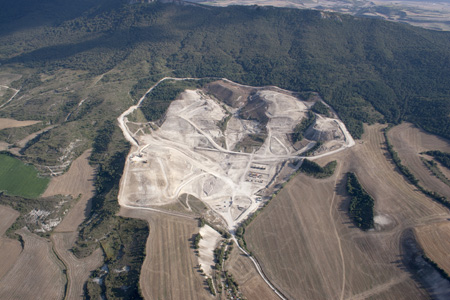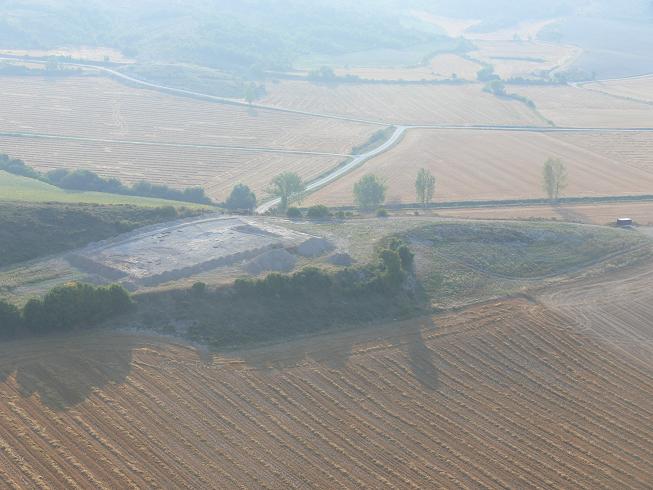The University of the Basque Country has conducted a study on a deserted (Zaballa) in Iruña de Oca (Álava), which was a Medieval village, abandoned in the fifteenth century. Five centuries before, it was a farm specialist in the hands of local lords, where some fields were built to intensive cultivation of vine.

Zaballa, Alava, Basque Country, Nort of Spain
Besides having an intake of important catchment system of income, became a true factory trying to get the greatest benefits of the economic boom of sheltered villas as Vitoria. By the fifteenth century the inhabitants moved to other towns and Zaballa ended abandoned.
This nucleus is the first in Spain to have deserted its own publication. Archaeologists from the University of the Basque Country (UPV / EHU) attempt to reconstruct and rescue our rural heritage by studying depopulated as Zaballa, whose research has been published in a special issue of the magazine “Quaternary International”.
"The studies archaeobotanical remains of seeds found in excavations, and pollen studies have provided material evidence of the existence of vines growing at a relatively early date, as the tenth century", said the Director of the Group Research on Cultural Heritage and Landscape of the UPV / EHU, Juan Antonio Quirós.
It has indicated that they have found metal instrumental for cultivation of the vine, which together with the study of agricultural areas reveals that "there developed agricultural practices are not compatible with cereal crops and yes with vines".
The publication includes the geoarchaeological works in Zaballa and Zornoztegi (Salvatierra), another deserted of Alava abandoned in the fifteenth century, and where the terraced fields were intended for the cultivation of cereal.

Zornoztegi, Alava, Basque Country, North of Spain
These discoveries were made possible by the use of protocols archaeological excavation, geoarchaeological innovative sampling and analysis in Spain, who have made dating cultivated fields and study the agricultural cycle.
"It is not much to excavate a site, the digging landscapes. Ie, abandon the traditional concept of field, understood as a monumental or monumentalised place to know the context in which the sites are”, has stated Quirós.
Zaballa is one of the 300 uninhabited known in Álava, rural areas abandoned in historical times. These deposits are one of the most important archeological records throughout the medieval period, in all the North of Spain, comparable to few sites of Europe: "What matters is not only the number, but in the decade we have been working on this project has involved extensively in nearly half a dozen of them, and other levels in nearly a hundred”.
Compared to Zaballa, according to Quiros, "Zornoztegi has a completely different story, although based on a more or less the same time, it is a much flatter social community in which no important social differences are observed, and the action of stately powers, somehow, they attack the balance of the community”.
For the researcher, these microhistories are small windows into the past, which analyze relatively complex directly from the bottom up historical processes. "I mean, watching the peasant community it will adapt itself to changing political and economic changes taking place in the Middle Ages and beyond”.
The early medieval periods were complex socially and economically significant.
Besides the analytical study of these production sites allows discard those points more traditional view of History, that "the early medieval periods conceptualized as a period of technical simplification, as a miserable period in economic terms, as they show a social and economic complexity very noticeable. Specifically, these studies have been able to see several important moments in the Basque Country, V-VI centuries and the X-XI centuries, which are crucial in the construction of our landscapes".
The study provide insight not only depopulated phenomena training of people and the reasons for its subsequent abandonment, but especially the processes of transformation and degradation of unpopulated.
Therefore, Quiros claimed the consideration of these points as part of the archaeological heritage: "Spaces crop traditional still easily recognizable in our more coming landscapes are historical spaces laden explanatory significance for understanding past societies, and indeed require of care that so far have not had ", concluded.
In fact, the analyzed crop fields are gradually being destroyed, year after year, as a result of recent mechanized agricultural practices have had and have a very significant destructive effect on this "invisible" assets.
This research was conducted by the Professor of Archaeology and Director of the Research Group on Cultural Heritage and Landscape of the UPV / EHU, Juan Antonio Quirós Castillo, in collaboration with researchers from the Free University of Brussels and the Institute of History of the CSIC in Madrid .
This group and research within the Department of Geography, Prehistory and Archaeology, Faculty of Arts at the UPV / EHU, in Vitoria-Gasteiz. The Research Group on Cultural Heritage and Landscape of the UPV / EHU studying depopulated started in 2005 and is a pioneer in the study of such deposits in the northern Spain.
I think that it is very interesting , Do not you think the same?.
Till soon, kind regards,
Luis.
Sponsored by Costaluz Lawyers.
Please click down here:
